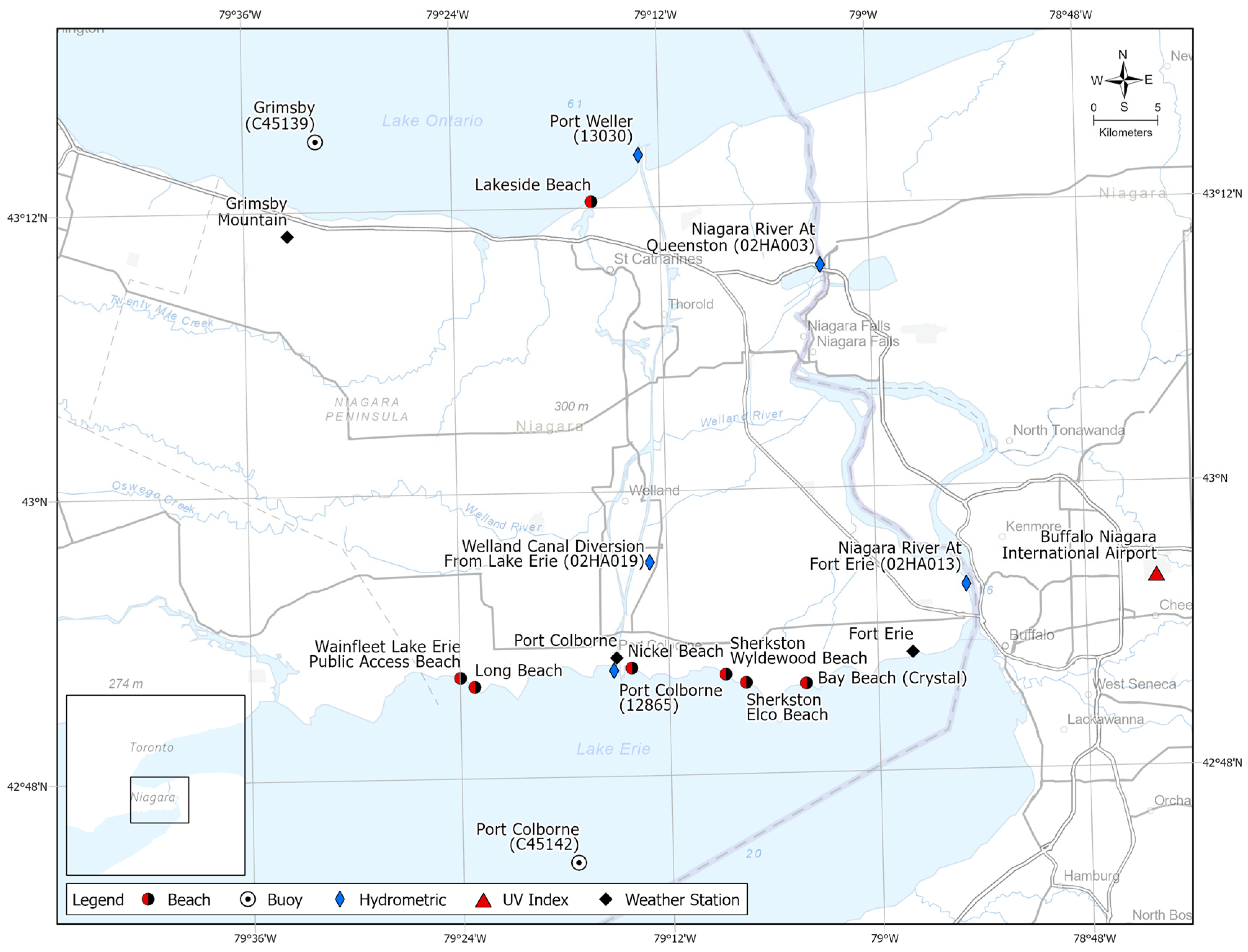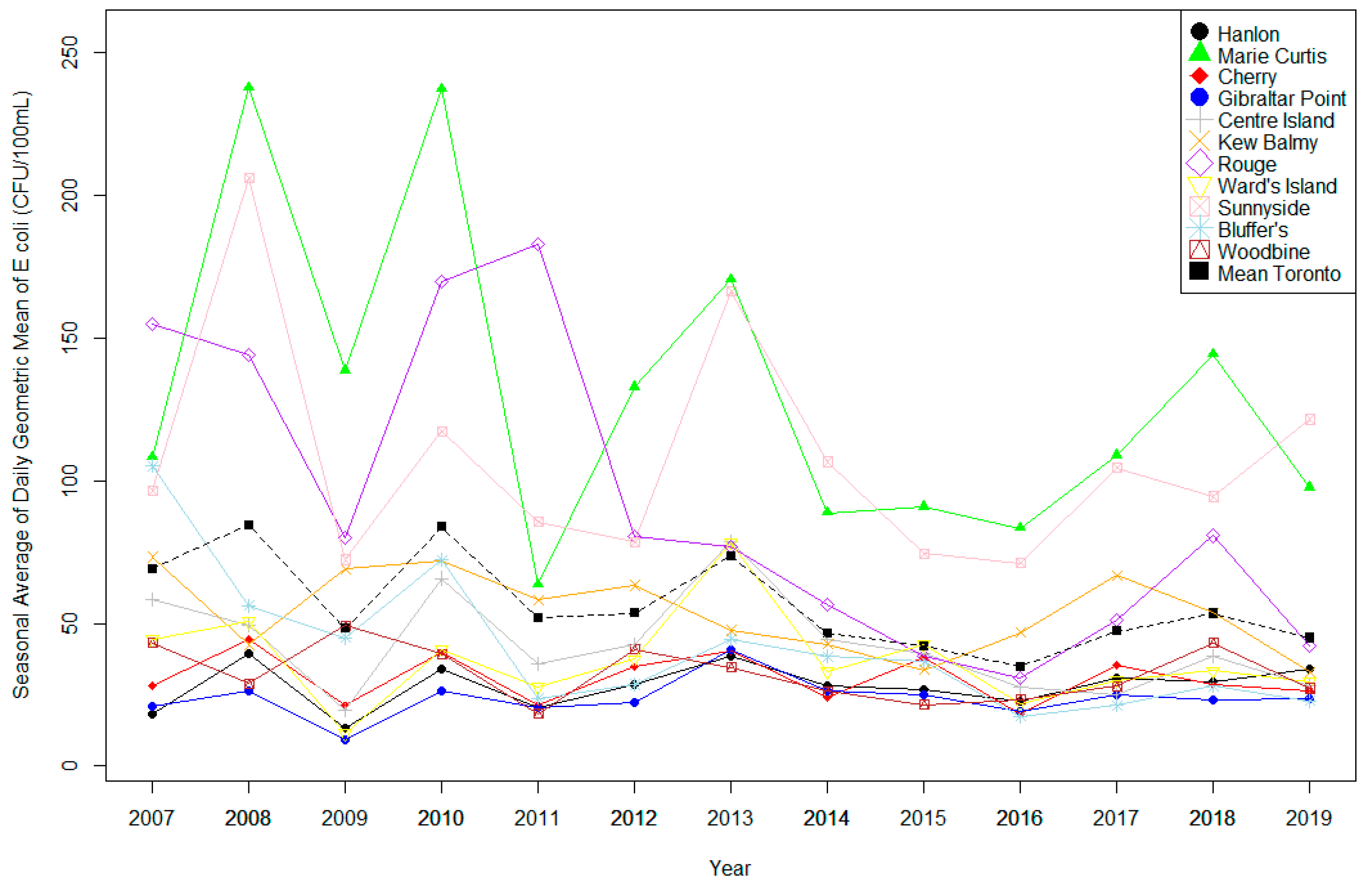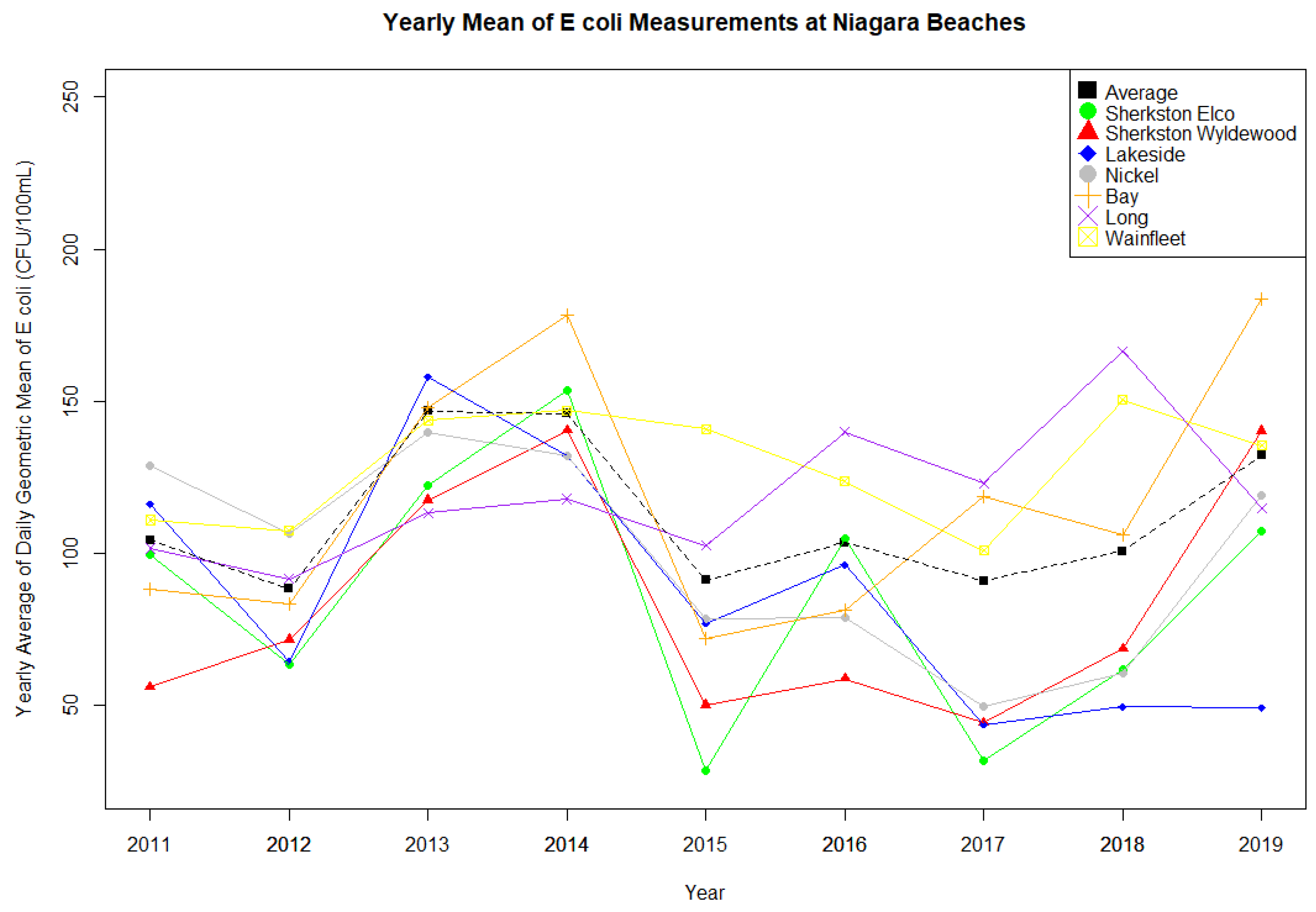Region-Specific Associations between Environmental Factors and Escherichia coli in Freshwater Beaches in Toronto and Niagara Region, Canada
Abstract
:1. Introduction
2. Materials and Methods
2.1. Study Area
2.2. Water Sampling Data
2.3. Environmental Data
2.4. Statistical Analysis
3. Results
3.1. Descriptive Data
3.2. Toronto Mixed Effects Models
3.3. Niagara Mixed Effects Models
4. Discussion
Limitations
5. Conclusions
Supplementary Materials
Author Contributions
Funding
Institutional Review Board Statement
Informed Consent Statement
Data Availability Statement
Conflicts of Interest
References
- Lawrence, S.J. Escherichia coli Bacteria Density in Relation to Turbidity, Streamflow Characteristics, and Season in the Chattahoochee River near Atlanta, Georgia, October 2000 through September 2008—Description, Statistical Analysis, and Predictive Modeling; US Geological Survey: Reston, VA, USA, 2012. [Google Scholar]
- Health Canada. Guidelines for Canadian Recreational Water Quality; Water, Air and Climate Change Burearu, Healthy Environments and Consumer Safety Branch: Toronto, ON, Canada, 2012. [Google Scholar]
- Government of Ontario. Operational Approaches for Recreational Water Guideline, 2018. In Oper Approaches Recreat Water Guidel 2018; Government of Ontario: Toronto, ON, Canada, 2018; pp. 1–14. [Google Scholar]
- Whitman, R.L.; Nevers, M.B.; Korinek, G.C.; Byappanahalli, M.N. Solar and temporal effects on Escherichia coli concentration at a Lake Michigan swimming beach. Appl. Environ. Microbiol. 2004, 70, 4276–4285. [Google Scholar] [CrossRef] [PubMed] [Green Version]
- Francy, D.S.; Stelzer, E.A.; Duris, J.W.; Brady, A.M.G.; Harrison, J.H.; Johnson, H.E.; Ware, M.W. Predictive models for Escherichia coli concentrations at inland lake beaches and relationship of model variables to pathogen detection. Appl. Environ. Microbiol. 2013, 79, 1676–1688. [Google Scholar] [CrossRef] [PubMed] [Green Version]
- Sampson, R.W.; Swiatnicki, S.A.; McDermott, C.M.; Kleinheinz, G.T. The effects of rainfall on Escherichia coli and total coliform levels at 15 Lake Superior recreational beaches. Water Resour. Manag. 2006, 20, 151–159. [Google Scholar] [CrossRef]
- Jang, J.; Hur, H.G.; Sadowsky, M.J.; Byappanahalli, M.N.; Yan, T.; Ishii, S. Environmental Escherichia coli: Ecology and public health implications—A review. J. Appl. Microbiol. 2017, 123, 570–581. [Google Scholar] [CrossRef] [PubMed] [Green Version]
- Kleinheinz, G.T.; McDermott, C.M.; Hughes, S.; Brown, A. Effects of rainfall on E. coli concentrations at Door County, Wisconsin Beaches. Int. J. Microbiol. 2009, 12, 876050. [Google Scholar]
- McLellan, S.L.; Salmore, A.K. Evidence for localized bacterial loading as the cause of chronic beach closings in a freshwater marina. Water Res. 2003, 37, 2700–2708. [Google Scholar] [CrossRef]
- Largier, J.L.; Taggart, M. Improving water quality at enclosed beaches. In A Report on the Enclosed Beach Symposium and Workshop (Clean Beaches Initiative); Bodega Marine Laboratory, University of California Davis: Bodega Bay, CA, USA, 2006. [Google Scholar]
- Government of Ontario. Recreational Water Protocol; Government of Ontario: Toronto, ON, Canada, 2018; pp. 1–13.
- Heasley, C.; Sanchez, J.J.; Tustin, J.; Young, I. Systematic review of predictive models of microbial water quality at freshwater recreational beaches. PLoS ONE 2021, 16, e0256785. [Google Scholar] [CrossRef] [PubMed]
- Toronto. Toronto at a Glance. City Government. 2021. Available online: https://www.toronto.ca/city-government/data-research-maps/toronto-at-a-glance/ (accessed on 29 May 2021).
- Toronto. Tourism. 2021. Available online: https://www.toronto.ca/business-economy/industry-sector-support/tourism/ (accessed on 29 May 2021).
- Niagara Region Open Data. 2021. Available online: https://niagaraopendata.ca/organization/about/niagara-region (accessed on 19 January 2021).
- Niagara Falls Canada. Tourism Research. 2021. Available online: https://www.niagarafallstourism.com/media-kit/contact/tourism-research/ (accessed on 20 January 2021).
- Ministry of the Environment Laboratory Services Branch. Protocol of Accepted Drinking Water Testing Methods Verison 2.0; Ministry of the Environment Laboratory Services Branch: Rancho Cordova, CA, USA, 2010.
- Government of Canada. Hiostorical Data—Environment and Natural Resources. 2020. Available online: https://climate.weather.gc.ca/historical_data/search_historic_data_e.html (accessed on 3 August 2020).
- Climate Prediction Center Internet Team. NOAA National Weather Service Climate Prediction Centre. 2021. Available online: https://www.cpc.ncep.noaa.gov/products/stratosphere/uv_index/uv_annual.shtml (accessed on 13 October 2020).
- StataCorp. Stata Statistical Software: Release 14; StataCorp: College Station, TX, USA, 2015. [Google Scholar]
- Environment and Climate Change Canada, U.S. Environmental Protection Agency. State of the Great Lakes 2019 Technical Report. Available online: https://binational.net/ (accessed on 14 April 2021).
- Rea, C.L.; Bisesi, M.S.; Mitsch, W.; Andridge, R.; Lee, J. Human Health-Related Ecosystem Services of Avian-Dense Coastal Wetlands Adjacent to a Western Lake Erie Swimming Beach. EcoHealth 2015, 12, 77–87. [Google Scholar] [CrossRef] [PubMed]
- Jones, R.M.; Liu, L.; Dorevitch, S. Hydrometeorological variables predict fecal indicator bacteria densities in freshwater: Data-driven methods for variable selection. Environ. Monit Assess. 2013, 185, 2355–2366. [Google Scholar] [CrossRef] [PubMed]
- Edge, T.A.; Hill, S.; Crowe, A.; Marsalek, J.; Seto, P.; Snodgrass, B.; Toninger, R.; Patel, M. Remediation of a Beneficial Use Impairment at Bluffer’s Park Beach in the Toronto Area of Concern. Aquat. Ecosyst. Health Manag. 2018, 21, 285–292. [Google Scholar] [CrossRef]
- Ji, Z.G. Hydrodynamics and Water Quality: Modeling Rivers, Lakes, and Estuaries; John Wiley and Sons: Hoboken, NJ, USA, 2008. [Google Scholar]
- Ge, Z.; Nevers, M.B.; Schwab, D.J.; Whitman, R.L. Coastal Loading and Transport of Escherichia coli at an Embayed Beach in Lake Michigan. Environ. Sci. Technol. 2021, 44, 6731–6737. [Google Scholar] [CrossRef] [PubMed]
- Kodoth, V.; Jones, M. The Effects of Ultraviolet Light on Escherichia coli. J. Emerg. Investig. 2015, 102, 23–28. [Google Scholar]
- Edge, T.A.; Stinson, G.; Seto, P.; Marsalek, J. Tracking sources of microbial pollution in recreational waters: Experience from two Toronto beaches. Novatech 2007, 2007, 1649–1656. [Google Scholar]






| Toronto Beaches | Lake | Niagara Beaches | Lake |
|---|---|---|---|
| Bluffer’s Beach Park | Ontario | Bay Beach | Erie |
| Centre Island Beach | Ontario | Lakeside Beach | Ontario |
| Cherry Beach | Ontario | Long Beach | Erie |
| Gibraltar’s Point Beach | Ontario | Nickel beach | Erie |
| Hanlan’s Point Beach | Ontario | Sherkston Elco Beach | Erie |
| Kew Balmy Beach | Ontario | Sherkston Wyldewood Beach | Erie |
| Marie Curtis Park East Beach | Ontario | Wainfleet Lake Erie | Erie |
| Rouge Beach | Ontario | Public Access Beach | Erie |
| Sunnyside Beach | Ontario | ||
| Ward’s Island Beach | Ontario | ||
| Woodbine Beach | Ontario |
| Variable | Toronto (2007–2019) | Niagara (2011–2019) |
|---|---|---|
| Air Temperature | Weather Station | Weather Station, Beach |
| Rainfall | Weather Station | Weather Station |
| Solar radiation | Irradiance | UV |
| Stream Flow | River sensor | River sensor |
| Turbidity | Lifeguard qualitative observation | Beach |
| Waterfowl | Lifeguard observation | NA |
| Water Level | Buoy | Buoy |
| Water Temperature | Buoy | Buoy, Beach |
| Wave Height | Buoy | Buoy, Beach |
| Wind Speed | Buoy | Buoy |
| Linear Response | Categorical Response—100 CFU/100 mL | Categorical Response—200 CFU/100 mL | |||||||
|---|---|---|---|---|---|---|---|---|---|
| Estimate | SE | p-Value | Estimate | SE | p-Value | Estimate | SE | p-Value | |
| Fixed effects | |||||||||
| 48 h total rainfall | 0.012 | 0.001 | <0.001 | 0.027 | 0.003 | <0.001 | 0.032 | 0.003 | <0.001 |
| 24 h air temperature | 0.033 | 0.002 | <0.001 | 0.104 | 0.013 | <0.001 | 0.090 | 0.017 | <0.001 |
| 24 h mean UV | −0.001 | 0.0001 | 0.002 | −0.003 | 0.0005 | <0.001 | −0.003 | 0.001 | <0.001 |
| Log10 stream discharge | 0.140 | 0.011 | <0.001 | 0.366 | 0.050 | <0.001 | 0.248 | 0.064 | <0.001 |
| 24 h Log10 E. coli | 0.242 | 0.005 | <0.001 | 0.508 | 0.025 | <0.001 | 0.408 | 0.026 | <0.001 |
| Water level | −0.130 | 0.059 | 0.028 | ||||||
| Water clarity | |||||||||
| Clear | ref | ref | ref | ||||||
| Mixed | 0.091 | 0.057 | 0.110 | 0.141 | 0.273 | 0.606 | 0.406 | 0.369 | 0.271 |
| Murky | 0.367 | 0.015 | <0.001 | 1.094 | 0.075 | <0.001 | 1.132 | 0.107 | <0.001 |
| Waterfowl | |||||||||
| 0 | ref | ref | ref | ||||||
| 1–49 | 0.032 | 0.019 | 0.092 | −0.018 | 0.105 | 0.865 | 0.061 | 0.148 | 0.679 |
| 50–99 | 0.064 | 0.027 | 0.020 | 0.022 | 0.144 | 0.881 | 0.444 | 0.194 | 0.022 |
| ≥100 | 0.104 | 0.036 | 0.004 | 0.088 | 0.171 | 0.606 | 0.497 | 0.229 | 0.030 |
| Year | |||||||||
| 2008 | ref | ref | ref | ||||||
| 2009 | −0.080 | 0.040 | 0.047 | −0.289 | 0.189 | 0.128 | −0.171 | 0.243 | 0.482 |
| 2010 | −0.089 | 0.037 | 0.015 | −0.303 | 0.152 | 0.047 | −0.609 | 0.202 | 0.003 |
| 2011 | −0.279 | 0.033 | <0.001 | −1.145 | 0.174 | <0.001 | −0.772 | 0.228 | 0.001 |
| 2012 | −0.306 | 0.040 | <0.001 | −1.143 | 0.176 | <0.001 | −0.912 | 0.237 | <0.001 |
| 2013 | −0.116 | 0.034 | 0.001 | −0.633 | 0.160 | <0.001 | −0.007 | 0.205 | 0.972 |
| 2014 | −0.170 | 0.034 | <0.001 | −0.549 | 0.163 | 0.001 | −0.692 | 0.238 | 0.004 |
| 2015 | −0.228 | 0.034 | <0.001 | −0.697 | 0.167 | <0.001 | −0.570 | 0.243 | 0.019 |
| 2016 | −0.253 | 0.037 | <0.001 | −1.158 | 0.215 | <0.001 | −1.024 | 0.313 | 0.001 |
| 2017 | −0.207 | 0.053 | <0.001 | −0.890 | 0.202 | <0.001 | −0.514 | 0.274 | 0.061 |
| 2018 | −0.242 | 0.034 | <0.001 | −1.195 | 0.174 | <0.001 | −0.776 | 0.230 | 0.001 |
| 2019 | −0.142 | 0.050 | 0.005 | 0.597 | 0.178 | 0.001 | −0.433 | 0.249 | 0.082 |
| Variance | SE | Variance | SE | Variance | SE | ||||
| Random effects | |||||||||
| Beach | 0.110 | 0.047 | 0.848 | 0.387 | 0.991 | 0.445 | |||
| Linear Response | Categorical Response—100 CFU/100 mL | Categorical Response—200 CFU/100 mL | |||||||
|---|---|---|---|---|---|---|---|---|---|
| Estimate | SE | p-Value | Estimate | SE | p-Value | Estimate | SE | p-Value | |
| Fixed effects | |||||||||
| 48 h total rainfall | 0.010 | 0.002 | <0.001 | 0.011 | 0.006 | 0.054 | −0.009 | 0.005 | 0.018 |
| 24 h air temp | 0.081 | 0.006 | <0.001 | 0.125 | 0.013 | <0.001 | 0.099 | 0.012 | <0.001 |
| 24 h mean UV | −0.022 | 0.159 | 0.040 | −0.026 | 0.388 | 0.296 | 0.001 | 0.022 | 0.965 |
| 24 h Log10 E. coli | 0.150 | 0.010 | <0.001 | 0.292 | 0.024 | <0.001 | 0.287 | 0.034 | <0.001 |
| Water level | 0.682 | 0.015 | <0.001 | 1.919 | 0.039 | <0.001 | 1.704 | 0.340 | <0.001 |
| Turbidity | 0.010 | 0.001 | <0.001 | 0.007 | 0.004 | 0.115 | 0.003 | 0.003 | 0.298 |
| Wave height | 0.067 | 0.003 | <0.001 | 0.076 | 0.010 | <0.001 | 0.060 | 0.008 | <0.001 |
| Year | |||||||||
| 2011 | Ref | ||||||||
| 2012 | 0.031 | 0.093 | 0.741 | 0.538 | 0.228 | 0.229 | 0.359 | 0.197 | 0.069 |
| 2013 | 0.341 | 0.082 | <0.001 | 0.559 | 0.215 | 0.016 | 0.551 | 0.182 | 0.003 |
| 2014 | 0.361 | 0.075 | <0.001 | 0.175 | 0.191 | 0.129 | 0.443 | 0.164 | 0.007 |
| 2015 | −0.334 | 0.079 | <0.001 | −0.757 | 0.191 | 0.004 | −0.453 | 0.166 | 0.006 |
| 2016 | −0.128 | 0.080 | 0.108 | −0.481 | 0.194 | 0.024 | −0.362 | 0.167 | 0.030 |
| 2017 | −0.276 | 0.099 | 0.005 | −1.130 | 0.239 | 0.004 | −0.617 | 0.207 | 0.003 |
| 2018 | −0.304 | 0.091 | 0.001 | −0.960 | 0.222 | <0.001 | −0.676 | 0.191 | <0.001 |
| 2019 | −0.292 | 0.127 | 0.022 | −1.220 | 0.311 | <0.001 | −0.929 | 0.271 | 0.001 |
| Variance | SE | Variance | SE | Variance | SE | ||||
| Random effects | |||||||||
| Beach | 0.019 | 0.012 | 0.107 | 0.065 | 0.051 | 0.033 | |||
Publisher’s Note: MDPI stays neutral with regard to jurisdictional claims in published maps and institutional affiliations. |
© 2021 by the authors. Licensee MDPI, Basel, Switzerland. This article is an open access article distributed under the terms and conditions of the Creative Commons Attribution (CC BY) license (https://creativecommons.org/licenses/by/4.0/).
Share and Cite
Sanchez, J.; Tustin, J.; Heasley, C.; Patel, M.; Kelly, J.; Habjan, A.; Waterhouse, R.; Young, I. Region-Specific Associations between Environmental Factors and Escherichia coli in Freshwater Beaches in Toronto and Niagara Region, Canada. Int. J. Environ. Res. Public Health 2021, 18, 12841. https://doi.org/10.3390/ijerph182312841
Sanchez J, Tustin J, Heasley C, Patel M, Kelly J, Habjan A, Waterhouse R, Young I. Region-Specific Associations between Environmental Factors and Escherichia coli in Freshwater Beaches in Toronto and Niagara Region, Canada. International Journal of Environmental Research and Public Health. 2021; 18(23):12841. https://doi.org/10.3390/ijerph182312841
Chicago/Turabian StyleSanchez, Johanna, Jordan Tustin, Cole Heasley, Mahesh Patel, Jeremy Kelly, Anthony Habjan, Ryan Waterhouse, and Ian Young. 2021. "Region-Specific Associations between Environmental Factors and Escherichia coli in Freshwater Beaches in Toronto and Niagara Region, Canada" International Journal of Environmental Research and Public Health 18, no. 23: 12841. https://doi.org/10.3390/ijerph182312841
APA StyleSanchez, J., Tustin, J., Heasley, C., Patel, M., Kelly, J., Habjan, A., Waterhouse, R., & Young, I. (2021). Region-Specific Associations between Environmental Factors and Escherichia coli in Freshwater Beaches in Toronto and Niagara Region, Canada. International Journal of Environmental Research and Public Health, 18(23), 12841. https://doi.org/10.3390/ijerph182312841






